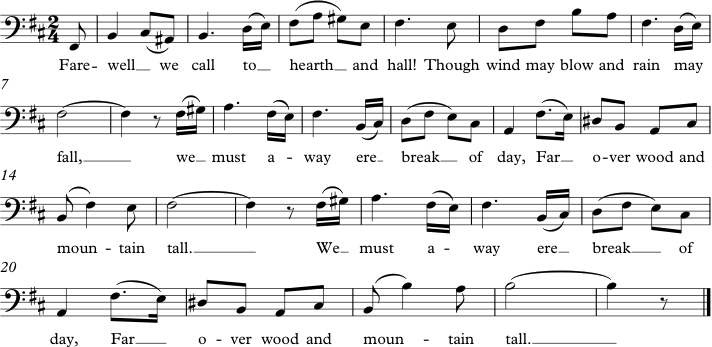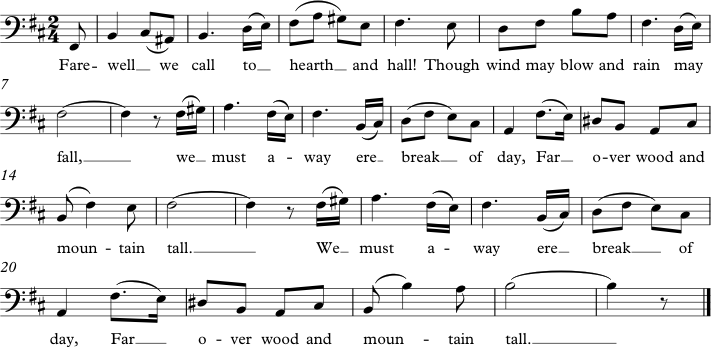Tolkien Ensemble, Farewell Song of Merry and Pippin, TE CD 1, Track 8, 3:08.
When discussing Dwarvish music we have already made the observation that all the songs given in the books were intended for outsiders to hear and therefore most likely adapted to their expectations. The Song of Durin is a prime example for such a song created only for outsiders as a tool of representation (see 4.1.4). We simply need to accept the fact that we do not have a single “private” Dwarven song performed only between Dwarves.
The unique trait of the Dwarven culture to actually adapt music to outside listeners, however, in itself is worthwhile to explore. We can see the lack of genuine Dwarvish songs as a chance to take their music as an example of cultural interaction. For this end there is a very fortunate finding to make, only mentioned briefly in passing: Before leaving Crickhollow, Merry and Pippin sing a song, which “made on the model of the dwarf-song that started Bilbo on his adventure long ago, and went to the same tune” (LotR, 106). From this we not only learn that Merry and Pippin used the same melody, but also that the song was based on the model of the dwarf-song – the song referred to here is probably Far over the misty mountains cold. That song is much longer, but it could be that Merry and Pippin wrote their lyrics just before they sang the song and simply did not have more time or found three and a half verses to be absolutely sufficient.
Farewell we call to hearth and hall!
Though wind may blow and rain may fall,
We must away ere break of day
Far over wood and mountain tall.
To Rivendell, where Elves yet dwell
In glades beneath the misty fell,
Through moor and waste we ride in haste,
And whither then we cannot tell.
Though wind may blow and rain may fall,
We must away ere break of day
Far over wood and mountain tall.
To Rivendell, where Elves yet dwell
In glades beneath the misty fell,
Through moor and waste we ride in haste,
And whither then we cannot tell.
With foes ahead, behind us dread,
Beneath the sky shall be our bed,
Until at last our toil be passed,
Our journey done, our errand sped.
We must away! We must away!
We ride before the break of day!
(LotR, 106)
Beneath the sky shall be our bed,
Until at last our toil be passed,
Our journey done, our errand sped.
We must away! We must away!
We ride before the break of day!
(LotR, 106)
The song clearly refers to the path the Hobbits would soon after embark on: Their destination, Rivendell, is mentioned and the “dreading foes” refer to the Ringwraiths (or Black Riders, as the Hobbits at that time did not yet know about the nature of the riders).
Because we know that the melody and the general model of the song are identical with the dwarf-song, but with a new text by Hobbits, it stands to reason to see what this combination of cultures brought forth. The Tolkien Ensemble has made a version of the song, called Farewell Song of Merry and Pippin, which in its tonal language is heavily oriented toward what we have observed as typical Hobbit music, but with a few unique twists that may be remnants of the Dwarvish origin of the song. The three full verses with four lines each are sung to the same melody. Here is the first verse:
transcription (first verse): Farewell Song of Merry and Pippin, TE CD 1, Track 8.
http://soundcloud.com/middle-earth-music/4-1-14-farewell-we-call/s-5ButR
The piece begins with an introduction of a solo violin playing the melody once through, but jumping directly from bar 8 to bar 17. The violin is accompanied by an accordion as well as what seems to be a twelve-string guitar. The singer then sings the first verse with identical instrumentation (0:19). The only textual change in all verses from the book is the repetition of the last two lines of every verse. The guitar strums a chord on every beat, which could be a part of the Dwarvish origin of the song. Maybe Bilbo heard the Dwarves play this way when they sang the song – Thorin’s harp would have been suitable for that task – and told Frodo of this stylistic characteristic of Dwarvish music. Frodo in turn may have told Merry and Pippin. In the second verse, a snare drum comes in (0:55), playing rolls. This element could hark back to Bombur’s drum. It is unlikely that he had a snare drum, but for a travel or marching song, the use of one makes sense. The drum is used even more prominently in the third verse (1:31), along with a closed hi-hat. These percussive elements, if indeed modelled after the music the Dwarves made at Bilbo’s “unexpected party”, give us an idea of how Dwarvish popular music (as opposed to more or less classical representative music like the Song of Durin) may sound: A catchy melody, suitable for chanting and with clear accents, as to be heard in large halls of stone, with a rather percussive accompaniment. Percussive instruments of all sorts could have been used, but we may imagine Dwarves to use quite a lot of metal percussion. With the quite complex mechanics of a hi-hat, they probably did not use this specific instrument, but they could have used some sort of cymbals or even bells.
The inclusion of the last verse with only two lines departs from the model of the dwarf-song from The Hobbit (2:10). We should lean towards not interpreting too much into this slight change – is seems as if the Hobbits merely wanted to have a nice ending to their song, which is actually supported by the way in which the Tolkien Ensemble dealt with these lines: They are sung not to the same melody as the first three verses, but instead after an instrumental interlude in the style of a horn call. Maybe Merry and Pippin with these lines alluded to the sound of the horn-call of Buckland, which was only sounded in dire need. After all they had found out about Frodo’s mission; bringing the Master Ring to a safe place, while being hunted by Ringwraiths in their opinion certainly counted as dire need and required a solid send-off. This also is the only part of the song where two singers (according to the book Merry and Pippin) sing together, partly in unison, partly in harmony.
http://soundcloud.com/middle-earth-music/4-1-14-farewell-we-call-ending/s-ULHHb
The piece ends with a repetition of the introduction (2:20) with added percussion and then fades away with the accordion played octave changes over the rhythm section.
Sadly, we need to be very careful when trying to apply any characteristics of the song to Dwarvish music in general. As mentioned before, the original song, Far over the misty mountains cold, very likely is an invention of Thorin and company. They wrote the lyrics and maybe even the melody. Again we need to remember the way all the material was passed on to us in the Red Book. Bilbo wrote down the words and the tune, probably some time after the actual events. We need to rely on his memory and hope he wrote everything down correctly, not accidentally mixing the Dwarven song with characteristics of Hobbit music. There is a bigger likelihood of such mistakes in the case of this song, because it probably was not widely known. The Song of Durin, on the contrary, certainly was. As one of the big representative songs of the Dwarven culture, a lot of people would have heard it, increasing the chances of readers of the Red Book spotting mistakes.


